Business Statistics Report: Retail Surge's Profit and User Analysis
VerifiedAdded on 2023/06/07
|28
|5646
|421
Report
AI Summary
This report provides a detailed statistical analysis of Retail Surge, an online retail company, focusing on key business aspects such as product profitability, cost of goods sold (COGS), payment method differences, and customer attitudes across different user groups and genders. The analysis employs various statistical tests, including ANOVA and independent sample t-tests, to determine significant differences and relationships within the data. Key findings include the identification of customized products as the most profitable and costly category, the lack of significant difference between PayPal and credit card payment methods, and significant variations in customer attitudes (knowledge, satisfaction, preference, purchase intention, and recommendation) among different user groups (light, medium, and heavy users). Gender differences in customer attitudes were also examined, revealing statistically significant variations in several key areas. The report concludes with a discussion of these findings and potential recommendations for Retail Surge to optimize its business strategies based on the data-driven insights.
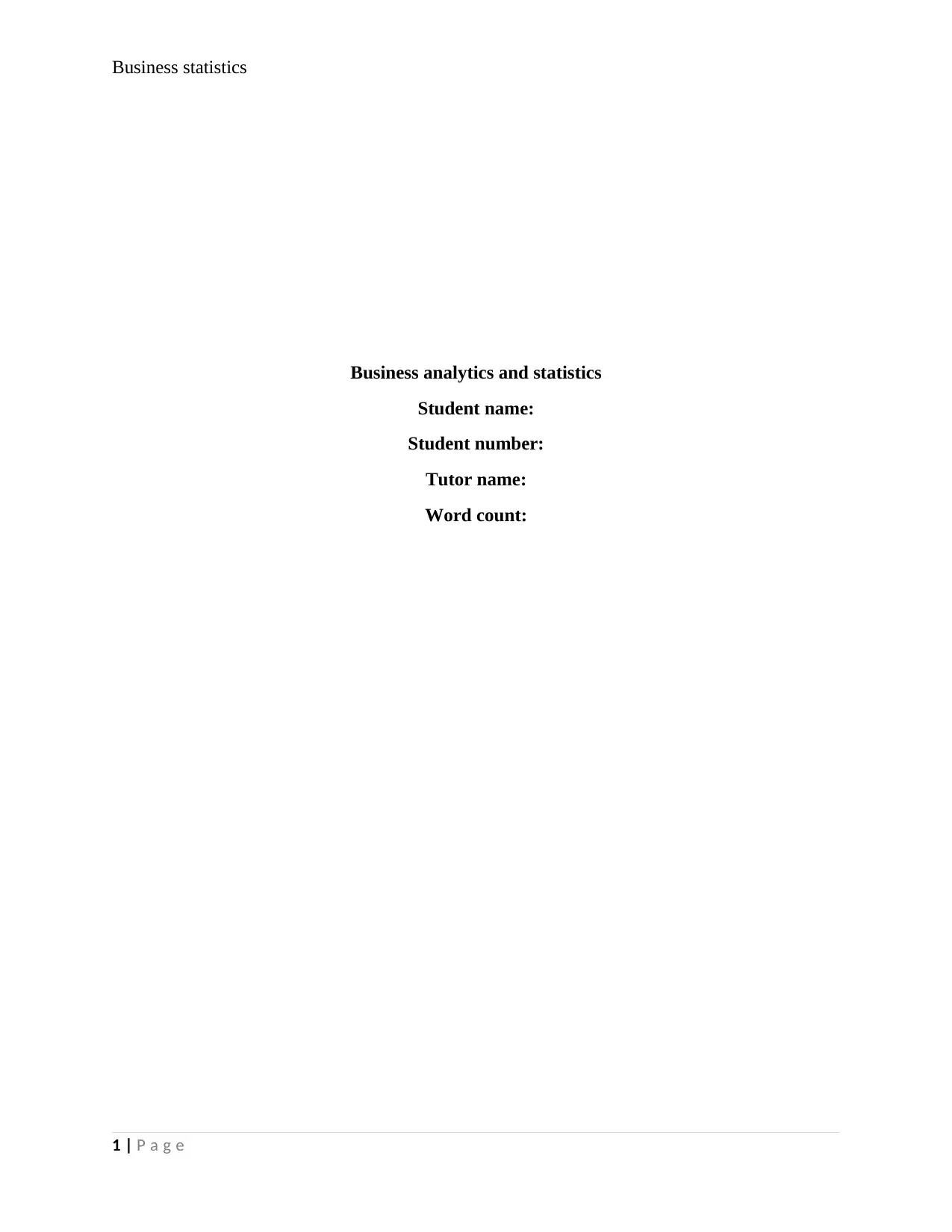
Business statistics
Business analytics and statistics
Student name:
Student number:
Tutor name:
Word count:
1 | P a g e
Business analytics and statistics
Student name:
Student number:
Tutor name:
Word count:
1 | P a g e
Paraphrase This Document
Need a fresh take? Get an instant paraphrase of this document with our AI Paraphraser

Business statistics
Table of Contents
1.0 Introduction...........................................................................................................................................3
2.0 Problem definition.................................................................................................................................3
3.0 Analysis and results...............................................................................................................................5
3.1 Which product categories are making the most profit?....................................................................5
3.2 Which product category costs the most (COGS)?..............................................................................6
3.3 Is there a difference in payments methods?.....................................................................................7
3.4 Are there any differences in the user groups on all of the customer attitudes? (6 outcomes)..........7
3.5 Test for the difference in means of user groups between different customer attitudes.................11
3.6 Are there any differences in gender on all of the customer attitudes? (6 outcomes).....................15
4.0 Discussion and recommendation.........................................................................................................20
Reference...................................................................................................................................................21
Appendix...................................................................................................................................................22
2 | P a g e
Table of Contents
1.0 Introduction...........................................................................................................................................3
2.0 Problem definition.................................................................................................................................3
3.0 Analysis and results...............................................................................................................................5
3.1 Which product categories are making the most profit?....................................................................5
3.2 Which product category costs the most (COGS)?..............................................................................6
3.3 Is there a difference in payments methods?.....................................................................................7
3.4 Are there any differences in the user groups on all of the customer attitudes? (6 outcomes)..........7
3.5 Test for the difference in means of user groups between different customer attitudes.................11
3.6 Are there any differences in gender on all of the customer attitudes? (6 outcomes).....................15
4.0 Discussion and recommendation.........................................................................................................20
Reference...................................................................................................................................................21
Appendix...................................................................................................................................................22
2 | P a g e
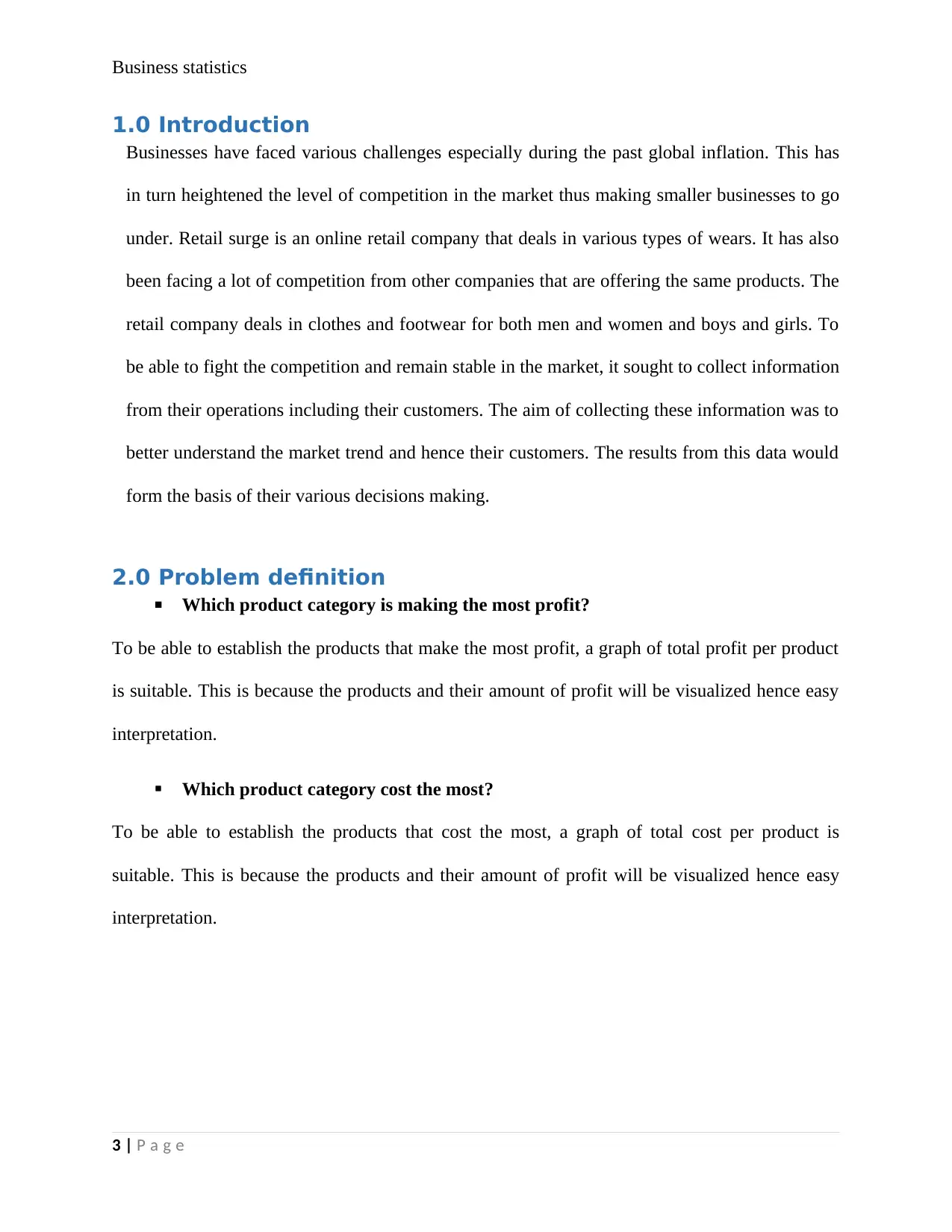
Business statistics
1.0 Introduction
Businesses have faced various challenges especially during the past global inflation. This has
in turn heightened the level of competition in the market thus making smaller businesses to go
under. Retail surge is an online retail company that deals in various types of wears. It has also
been facing a lot of competition from other companies that are offering the same products. The
retail company deals in clothes and footwear for both men and women and boys and girls. To
be able to fight the competition and remain stable in the market, it sought to collect information
from their operations including their customers. The aim of collecting these information was to
better understand the market trend and hence their customers. The results from this data would
form the basis of their various decisions making.
2.0 Problem definition
Which product category is making the most profit?
To be able to establish the products that make the most profit, a graph of total profit per product
is suitable. This is because the products and their amount of profit will be visualized hence easy
interpretation.
Which product category cost the most?
To be able to establish the products that cost the most, a graph of total cost per product is
suitable. This is because the products and their amount of profit will be visualized hence easy
interpretation.
3 | P a g e
1.0 Introduction
Businesses have faced various challenges especially during the past global inflation. This has
in turn heightened the level of competition in the market thus making smaller businesses to go
under. Retail surge is an online retail company that deals in various types of wears. It has also
been facing a lot of competition from other companies that are offering the same products. The
retail company deals in clothes and footwear for both men and women and boys and girls. To
be able to fight the competition and remain stable in the market, it sought to collect information
from their operations including their customers. The aim of collecting these information was to
better understand the market trend and hence their customers. The results from this data would
form the basis of their various decisions making.
2.0 Problem definition
Which product category is making the most profit?
To be able to establish the products that make the most profit, a graph of total profit per product
is suitable. This is because the products and their amount of profit will be visualized hence easy
interpretation.
Which product category cost the most?
To be able to establish the products that cost the most, a graph of total cost per product is
suitable. This is because the products and their amount of profit will be visualized hence easy
interpretation.
3 | P a g e
⊘ This is a preview!⊘
Do you want full access?
Subscribe today to unlock all pages.

Trusted by 1+ million students worldwide
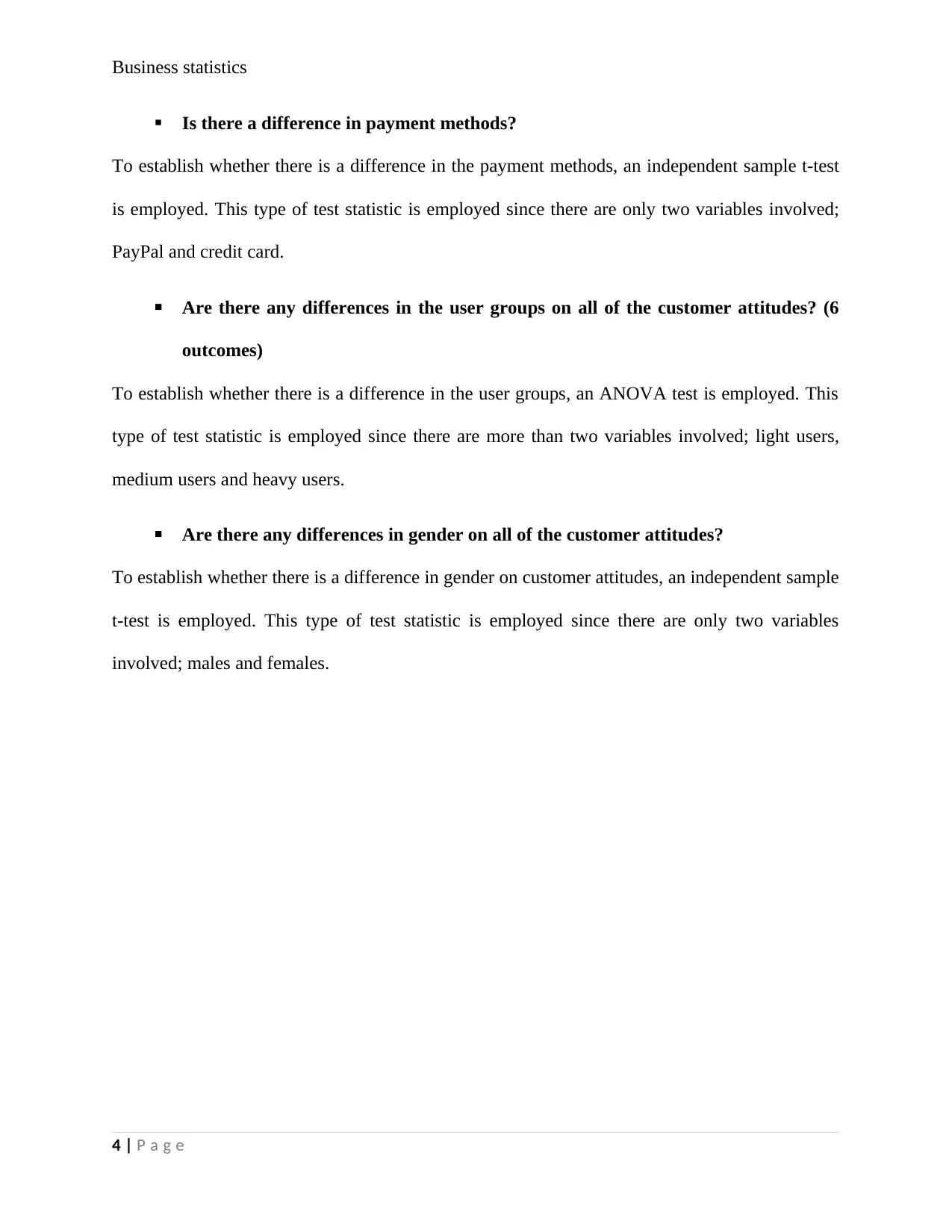
Business statistics
Is there a difference in payment methods?
To establish whether there is a difference in the payment methods, an independent sample t-test
is employed. This type of test statistic is employed since there are only two variables involved;
PayPal and credit card.
Are there any differences in the user groups on all of the customer attitudes? (6
outcomes)
To establish whether there is a difference in the user groups, an ANOVA test is employed. This
type of test statistic is employed since there are more than two variables involved; light users,
medium users and heavy users.
Are there any differences in gender on all of the customer attitudes?
To establish whether there is a difference in gender on customer attitudes, an independent sample
t-test is employed. This type of test statistic is employed since there are only two variables
involved; males and females.
4 | P a g e
Is there a difference in payment methods?
To establish whether there is a difference in the payment methods, an independent sample t-test
is employed. This type of test statistic is employed since there are only two variables involved;
PayPal and credit card.
Are there any differences in the user groups on all of the customer attitudes? (6
outcomes)
To establish whether there is a difference in the user groups, an ANOVA test is employed. This
type of test statistic is employed since there are more than two variables involved; light users,
medium users and heavy users.
Are there any differences in gender on all of the customer attitudes?
To establish whether there is a difference in gender on customer attitudes, an independent sample
t-test is employed. This type of test statistic is employed since there are only two variables
involved; males and females.
4 | P a g e
Paraphrase This Document
Need a fresh take? Get an instant paraphrase of this document with our AI Paraphraser
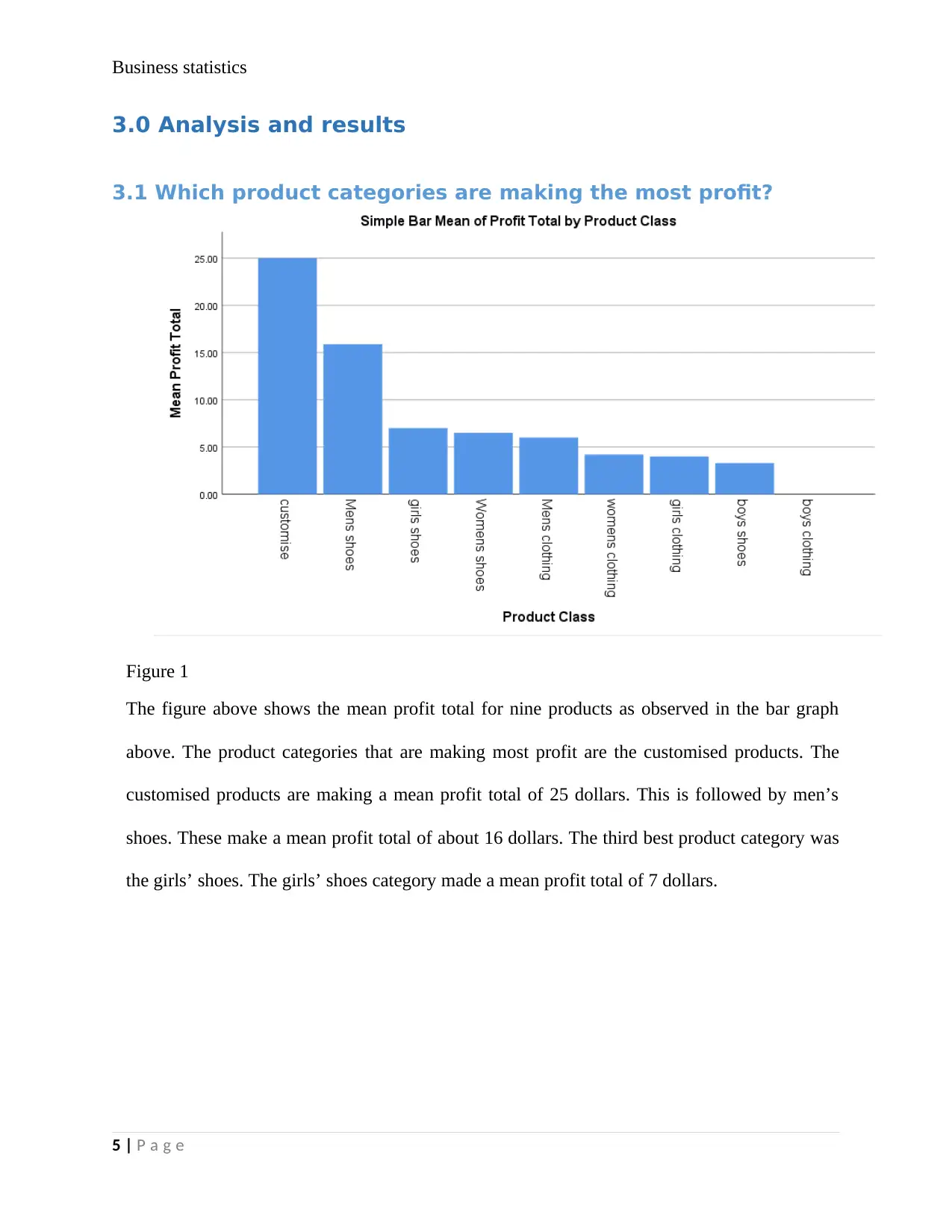
Business statistics
3.0 Analysis and results
3.1 Which product categories are making the most profit?
Figure 1
The figure above shows the mean profit total for nine products as observed in the bar graph
above. The product categories that are making most profit are the customised products. The
customised products are making a mean profit total of 25 dollars. This is followed by men’s
shoes. These make a mean profit total of about 16 dollars. The third best product category was
the girls’ shoes. The girls’ shoes category made a mean profit total of 7 dollars.
5 | P a g e
3.0 Analysis and results
3.1 Which product categories are making the most profit?
Figure 1
The figure above shows the mean profit total for nine products as observed in the bar graph
above. The product categories that are making most profit are the customised products. The
customised products are making a mean profit total of 25 dollars. This is followed by men’s
shoes. These make a mean profit total of about 16 dollars. The third best product category was
the girls’ shoes. The girls’ shoes category made a mean profit total of 7 dollars.
5 | P a g e
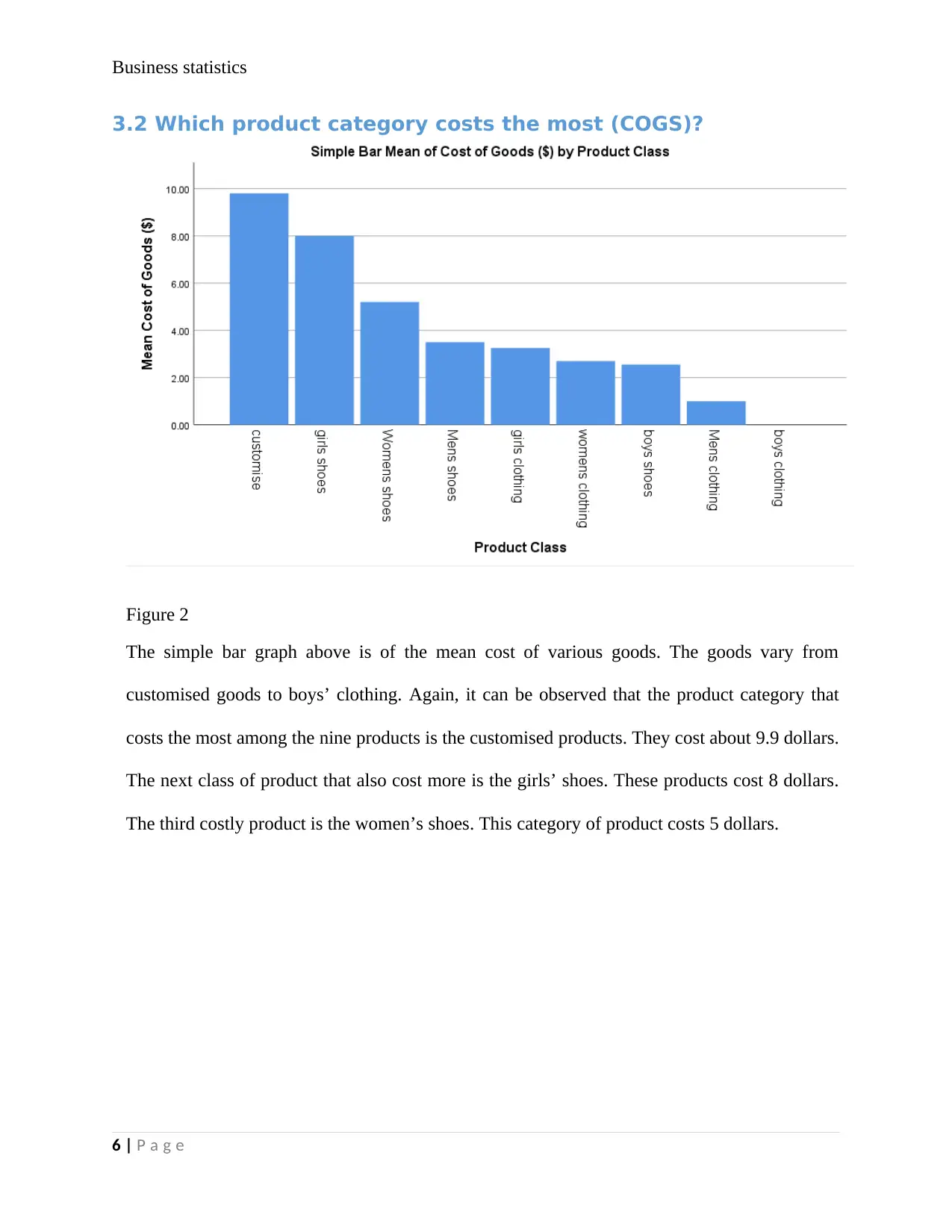
Business statistics
3.2 Which product category costs the most (COGS)?
Figure 2
The simple bar graph above is of the mean cost of various goods. The goods vary from
customised goods to boys’ clothing. Again, it can be observed that the product category that
costs the most among the nine products is the customised products. They cost about 9.9 dollars.
The next class of product that also cost more is the girls’ shoes. These products cost 8 dollars.
The third costly product is the women’s shoes. This category of product costs 5 dollars.
6 | P a g e
3.2 Which product category costs the most (COGS)?
Figure 2
The simple bar graph above is of the mean cost of various goods. The goods vary from
customised goods to boys’ clothing. Again, it can be observed that the product category that
costs the most among the nine products is the customised products. They cost about 9.9 dollars.
The next class of product that also cost more is the girls’ shoes. These products cost 8 dollars.
The third costly product is the women’s shoes. This category of product costs 5 dollars.
6 | P a g e
⊘ This is a preview!⊘
Do you want full access?
Subscribe today to unlock all pages.

Trusted by 1+ million students worldwide
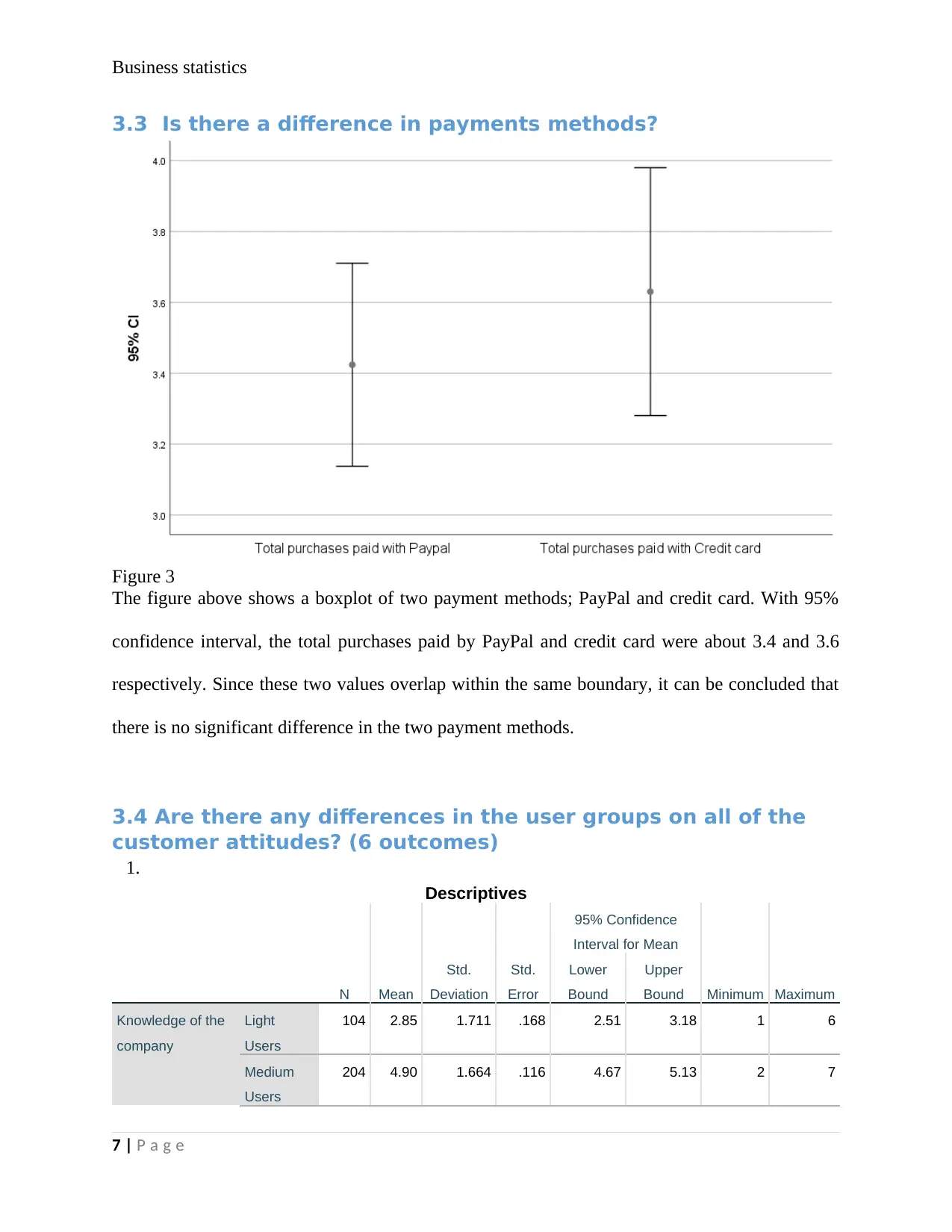
Business statistics
3.3 Is there a difference in payments methods?
Figure 3
The figure above shows a boxplot of two payment methods; PayPal and credit card. With 95%
confidence interval, the total purchases paid by PayPal and credit card were about 3.4 and 3.6
respectively. Since these two values overlap within the same boundary, it can be concluded that
there is no significant difference in the two payment methods.
3.4 Are there any differences in the user groups on all of the
customer attitudes? (6 outcomes)
1.
Descriptives
N Mean
Std.
Deviation
Std.
Error
95% Confidence
Interval for Mean
Minimum Maximum
Lower
Bound
Upper
Bound
Knowledge of the
company
Light
Users
104 2.85 1.711 .168 2.51 3.18 1 6
Medium
Users
204 4.90 1.664 .116 4.67 5.13 2 7
7 | P a g e
3.3 Is there a difference in payments methods?
Figure 3
The figure above shows a boxplot of two payment methods; PayPal and credit card. With 95%
confidence interval, the total purchases paid by PayPal and credit card were about 3.4 and 3.6
respectively. Since these two values overlap within the same boundary, it can be concluded that
there is no significant difference in the two payment methods.
3.4 Are there any differences in the user groups on all of the
customer attitudes? (6 outcomes)
1.
Descriptives
N Mean
Std.
Deviation
Std.
Error
95% Confidence
Interval for Mean
Minimum Maximum
Lower
Bound
Upper
Bound
Knowledge of the
company
Light
Users
104 2.85 1.711 .168 2.51 3.18 1 6
Medium
Users
204 4.90 1.664 .116 4.67 5.13 2 7
7 | P a g e
Paraphrase This Document
Need a fresh take? Get an instant paraphrase of this document with our AI Paraphraser
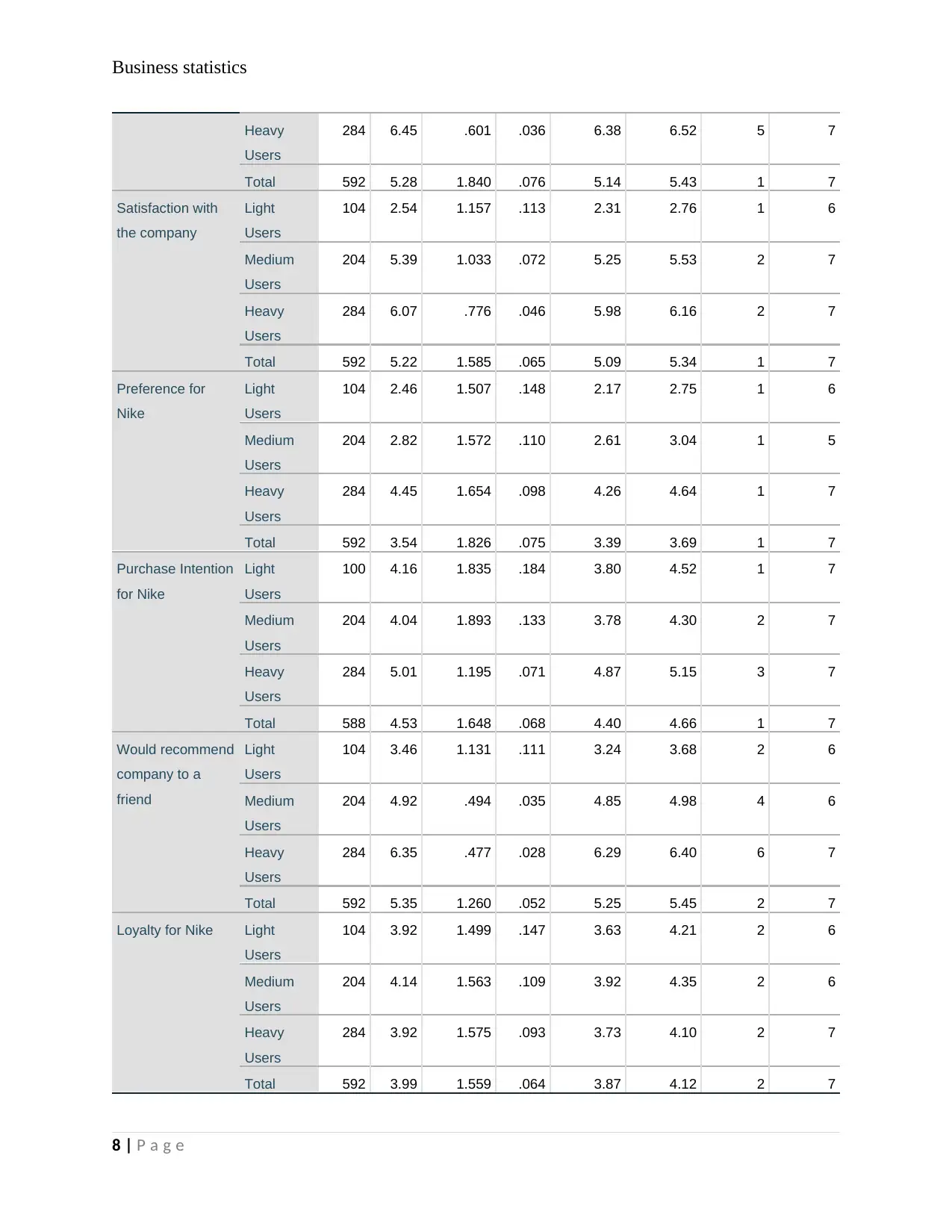
Business statistics
Heavy
Users
284 6.45 .601 .036 6.38 6.52 5 7
Total 592 5.28 1.840 .076 5.14 5.43 1 7
Satisfaction with
the company
Light
Users
104 2.54 1.157 .113 2.31 2.76 1 6
Medium
Users
204 5.39 1.033 .072 5.25 5.53 2 7
Heavy
Users
284 6.07 .776 .046 5.98 6.16 2 7
Total 592 5.22 1.585 .065 5.09 5.34 1 7
Preference for
Nike
Light
Users
104 2.46 1.507 .148 2.17 2.75 1 6
Medium
Users
204 2.82 1.572 .110 2.61 3.04 1 5
Heavy
Users
284 4.45 1.654 .098 4.26 4.64 1 7
Total 592 3.54 1.826 .075 3.39 3.69 1 7
Purchase Intention
for Nike
Light
Users
100 4.16 1.835 .184 3.80 4.52 1 7
Medium
Users
204 4.04 1.893 .133 3.78 4.30 2 7
Heavy
Users
284 5.01 1.195 .071 4.87 5.15 3 7
Total 588 4.53 1.648 .068 4.40 4.66 1 7
Would recommend
company to a
friend
Light
Users
104 3.46 1.131 .111 3.24 3.68 2 6
Medium
Users
204 4.92 .494 .035 4.85 4.98 4 6
Heavy
Users
284 6.35 .477 .028 6.29 6.40 6 7
Total 592 5.35 1.260 .052 5.25 5.45 2 7
Loyalty for Nike Light
Users
104 3.92 1.499 .147 3.63 4.21 2 6
Medium
Users
204 4.14 1.563 .109 3.92 4.35 2 6
Heavy
Users
284 3.92 1.575 .093 3.73 4.10 2 7
Total 592 3.99 1.559 .064 3.87 4.12 2 7
8 | P a g e
Heavy
Users
284 6.45 .601 .036 6.38 6.52 5 7
Total 592 5.28 1.840 .076 5.14 5.43 1 7
Satisfaction with
the company
Light
Users
104 2.54 1.157 .113 2.31 2.76 1 6
Medium
Users
204 5.39 1.033 .072 5.25 5.53 2 7
Heavy
Users
284 6.07 .776 .046 5.98 6.16 2 7
Total 592 5.22 1.585 .065 5.09 5.34 1 7
Preference for
Nike
Light
Users
104 2.46 1.507 .148 2.17 2.75 1 6
Medium
Users
204 2.82 1.572 .110 2.61 3.04 1 5
Heavy
Users
284 4.45 1.654 .098 4.26 4.64 1 7
Total 592 3.54 1.826 .075 3.39 3.69 1 7
Purchase Intention
for Nike
Light
Users
100 4.16 1.835 .184 3.80 4.52 1 7
Medium
Users
204 4.04 1.893 .133 3.78 4.30 2 7
Heavy
Users
284 5.01 1.195 .071 4.87 5.15 3 7
Total 588 4.53 1.648 .068 4.40 4.66 1 7
Would recommend
company to a
friend
Light
Users
104 3.46 1.131 .111 3.24 3.68 2 6
Medium
Users
204 4.92 .494 .035 4.85 4.98 4 6
Heavy
Users
284 6.35 .477 .028 6.29 6.40 6 7
Total 592 5.35 1.260 .052 5.25 5.45 2 7
Loyalty for Nike Light
Users
104 3.92 1.499 .147 3.63 4.21 2 6
Medium
Users
204 4.14 1.563 .109 3.92 4.35 2 6
Heavy
Users
284 3.92 1.575 .093 3.73 4.10 2 7
Total 592 3.99 1.559 .064 3.87 4.12 2 7
8 | P a g e
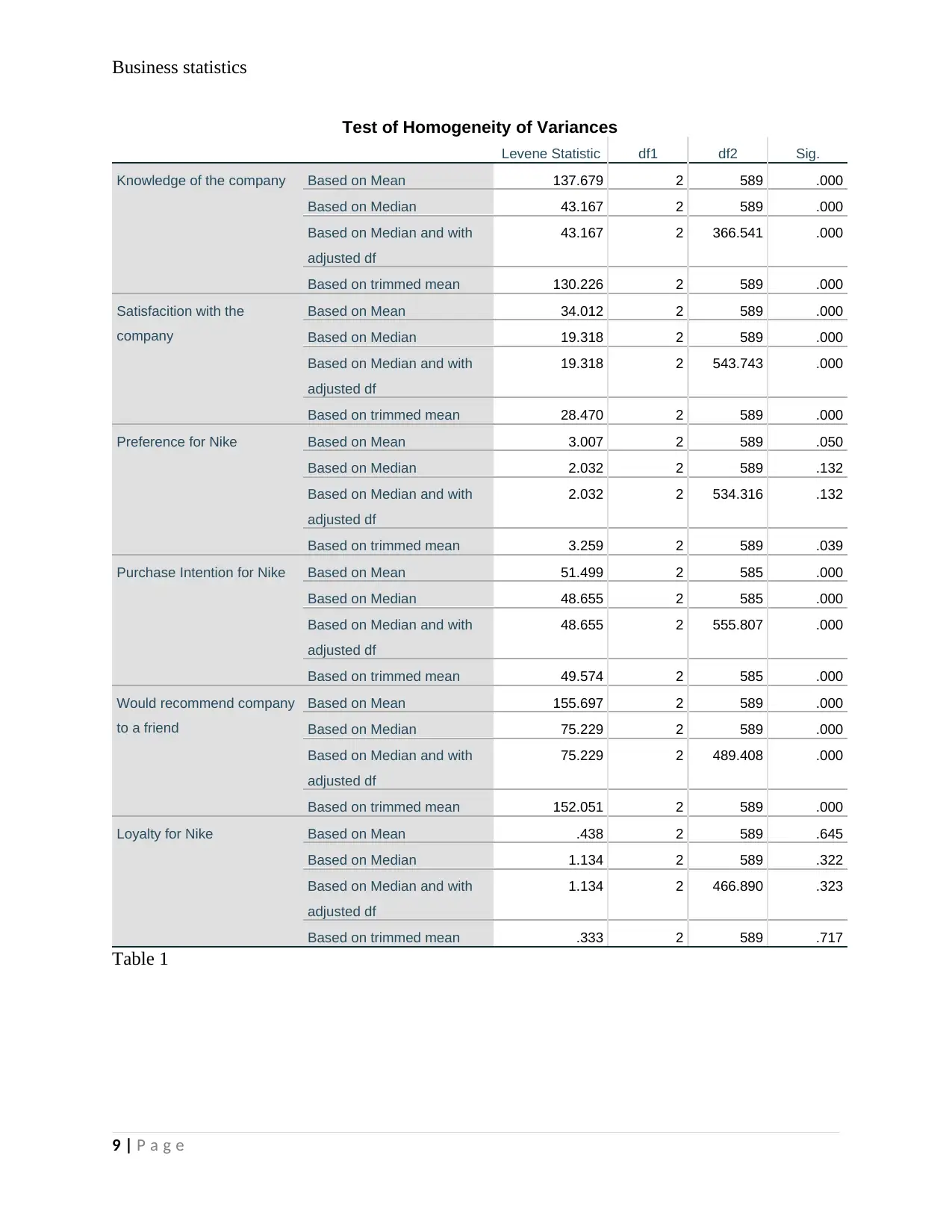
Business statistics
Test of Homogeneity of Variances
Levene Statistic df1 df2 Sig.
Knowledge of the company Based on Mean 137.679 2 589 .000
Based on Median 43.167 2 589 .000
Based on Median and with
adjusted df
43.167 2 366.541 .000
Based on trimmed mean 130.226 2 589 .000
Satisfacition with the
company
Based on Mean 34.012 2 589 .000
Based on Median 19.318 2 589 .000
Based on Median and with
adjusted df
19.318 2 543.743 .000
Based on trimmed mean 28.470 2 589 .000
Preference for Nike Based on Mean 3.007 2 589 .050
Based on Median 2.032 2 589 .132
Based on Median and with
adjusted df
2.032 2 534.316 .132
Based on trimmed mean 3.259 2 589 .039
Purchase Intention for Nike Based on Mean 51.499 2 585 .000
Based on Median 48.655 2 585 .000
Based on Median and with
adjusted df
48.655 2 555.807 .000
Based on trimmed mean 49.574 2 585 .000
Would recommend company
to a friend
Based on Mean 155.697 2 589 .000
Based on Median 75.229 2 589 .000
Based on Median and with
adjusted df
75.229 2 489.408 .000
Based on trimmed mean 152.051 2 589 .000
Loyalty for Nike Based on Mean .438 2 589 .645
Based on Median 1.134 2 589 .322
Based on Median and with
adjusted df
1.134 2 466.890 .323
Based on trimmed mean .333 2 589 .717
Table 1
9 | P a g e
Test of Homogeneity of Variances
Levene Statistic df1 df2 Sig.
Knowledge of the company Based on Mean 137.679 2 589 .000
Based on Median 43.167 2 589 .000
Based on Median and with
adjusted df
43.167 2 366.541 .000
Based on trimmed mean 130.226 2 589 .000
Satisfacition with the
company
Based on Mean 34.012 2 589 .000
Based on Median 19.318 2 589 .000
Based on Median and with
adjusted df
19.318 2 543.743 .000
Based on trimmed mean 28.470 2 589 .000
Preference for Nike Based on Mean 3.007 2 589 .050
Based on Median 2.032 2 589 .132
Based on Median and with
adjusted df
2.032 2 534.316 .132
Based on trimmed mean 3.259 2 589 .039
Purchase Intention for Nike Based on Mean 51.499 2 585 .000
Based on Median 48.655 2 585 .000
Based on Median and with
adjusted df
48.655 2 555.807 .000
Based on trimmed mean 49.574 2 585 .000
Would recommend company
to a friend
Based on Mean 155.697 2 589 .000
Based on Median 75.229 2 589 .000
Based on Median and with
adjusted df
75.229 2 489.408 .000
Based on trimmed mean 152.051 2 589 .000
Loyalty for Nike Based on Mean .438 2 589 .645
Based on Median 1.134 2 589 .322
Based on Median and with
adjusted df
1.134 2 466.890 .323
Based on trimmed mean .333 2 589 .717
Table 1
9 | P a g e
⊘ This is a preview!⊘
Do you want full access?
Subscribe today to unlock all pages.

Trusted by 1+ million students worldwide
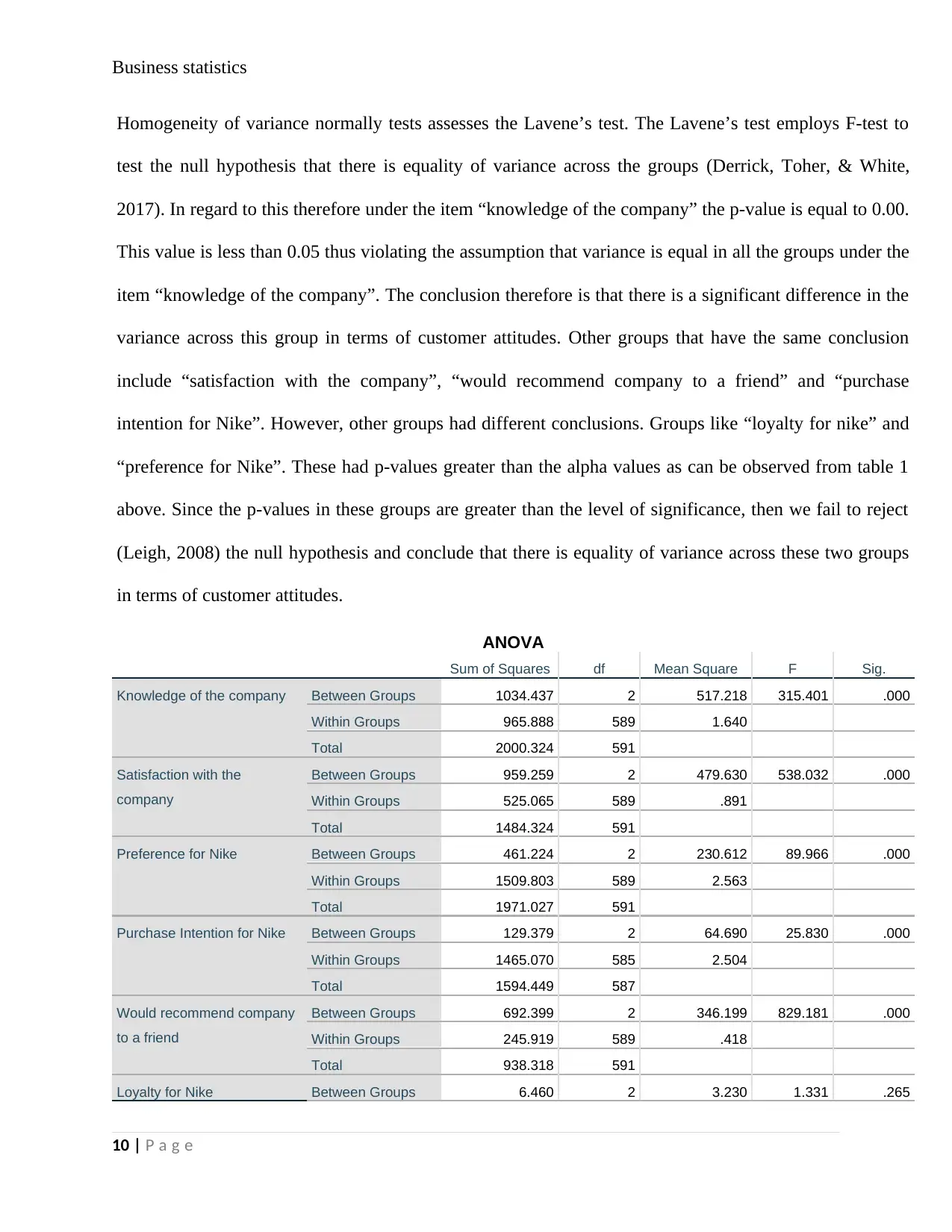
Business statistics
Homogeneity of variance normally tests assesses the Lavene’s test. The Lavene’s test employs F-test to
test the null hypothesis that there is equality of variance across the groups (Derrick, Toher, & White,
2017). In regard to this therefore under the item “knowledge of the company” the p-value is equal to 0.00.
This value is less than 0.05 thus violating the assumption that variance is equal in all the groups under the
item “knowledge of the company”. The conclusion therefore is that there is a significant difference in the
variance across this group in terms of customer attitudes. Other groups that have the same conclusion
include “satisfaction with the company”, “would recommend company to a friend” and “purchase
intention for Nike”. However, other groups had different conclusions. Groups like “loyalty for nike” and
“preference for Nike”. These had p-values greater than the alpha values as can be observed from table 1
above. Since the p-values in these groups are greater than the level of significance, then we fail to reject
(Leigh, 2008) the null hypothesis and conclude that there is equality of variance across these two groups
in terms of customer attitudes.
ANOVA
Sum of Squares df Mean Square F Sig.
Knowledge of the company Between Groups 1034.437 2 517.218 315.401 .000
Within Groups 965.888 589 1.640
Total 2000.324 591
Satisfaction with the
company
Between Groups 959.259 2 479.630 538.032 .000
Within Groups 525.065 589 .891
Total 1484.324 591
Preference for Nike Between Groups 461.224 2 230.612 89.966 .000
Within Groups 1509.803 589 2.563
Total 1971.027 591
Purchase Intention for Nike Between Groups 129.379 2 64.690 25.830 .000
Within Groups 1465.070 585 2.504
Total 1594.449 587
Would recommend company
to a friend
Between Groups 692.399 2 346.199 829.181 .000
Within Groups 245.919 589 .418
Total 938.318 591
Loyalty for Nike Between Groups 6.460 2 3.230 1.331 .265
10 | P a g e
Homogeneity of variance normally tests assesses the Lavene’s test. The Lavene’s test employs F-test to
test the null hypothesis that there is equality of variance across the groups (Derrick, Toher, & White,
2017). In regard to this therefore under the item “knowledge of the company” the p-value is equal to 0.00.
This value is less than 0.05 thus violating the assumption that variance is equal in all the groups under the
item “knowledge of the company”. The conclusion therefore is that there is a significant difference in the
variance across this group in terms of customer attitudes. Other groups that have the same conclusion
include “satisfaction with the company”, “would recommend company to a friend” and “purchase
intention for Nike”. However, other groups had different conclusions. Groups like “loyalty for nike” and
“preference for Nike”. These had p-values greater than the alpha values as can be observed from table 1
above. Since the p-values in these groups are greater than the level of significance, then we fail to reject
(Leigh, 2008) the null hypothesis and conclude that there is equality of variance across these two groups
in terms of customer attitudes.
ANOVA
Sum of Squares df Mean Square F Sig.
Knowledge of the company Between Groups 1034.437 2 517.218 315.401 .000
Within Groups 965.888 589 1.640
Total 2000.324 591
Satisfaction with the
company
Between Groups 959.259 2 479.630 538.032 .000
Within Groups 525.065 589 .891
Total 1484.324 591
Preference for Nike Between Groups 461.224 2 230.612 89.966 .000
Within Groups 1509.803 589 2.563
Total 1971.027 591
Purchase Intention for Nike Between Groups 129.379 2 64.690 25.830 .000
Within Groups 1465.070 585 2.504
Total 1594.449 587
Would recommend company
to a friend
Between Groups 692.399 2 346.199 829.181 .000
Within Groups 245.919 589 .418
Total 938.318 591
Loyalty for Nike Between Groups 6.460 2 3.230 1.331 .265
10 | P a g e
Paraphrase This Document
Need a fresh take? Get an instant paraphrase of this document with our AI Paraphraser
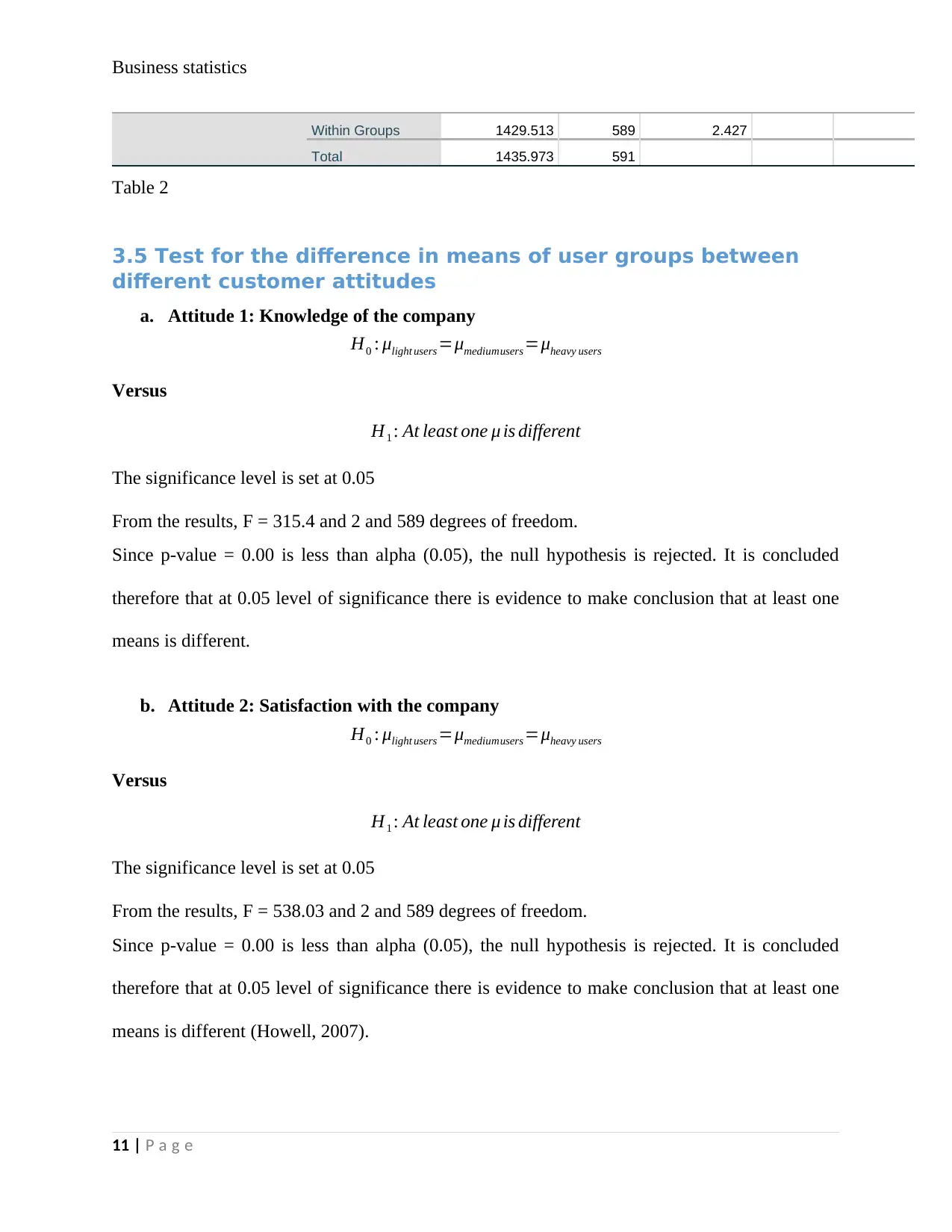
Business statistics
Within Groups 1429.513 589 2.427
Total 1435.973 591
Table 2
3.5 Test for the difference in means of user groups between
different customer attitudes
a. Attitude 1: Knowledge of the company
H0 : μlight users =μmediumusers =μheavy users
Versus
H1 : At least one μ is different
The significance level is set at 0.05
From the results, F = 315.4 and 2 and 589 degrees of freedom.
Since p-value = 0.00 is less than alpha (0.05), the null hypothesis is rejected. It is concluded
therefore that at 0.05 level of significance there is evidence to make conclusion that at least one
means is different.
b. Attitude 2: Satisfaction with the company
H0 : μlight users =μmediumusers =μheavy users
Versus
H1 : At least one μ is different
The significance level is set at 0.05
From the results, F = 538.03 and 2 and 589 degrees of freedom.
Since p-value = 0.00 is less than alpha (0.05), the null hypothesis is rejected. It is concluded
therefore that at 0.05 level of significance there is evidence to make conclusion that at least one
means is different (Howell, 2007).
11 | P a g e
Within Groups 1429.513 589 2.427
Total 1435.973 591
Table 2
3.5 Test for the difference in means of user groups between
different customer attitudes
a. Attitude 1: Knowledge of the company
H0 : μlight users =μmediumusers =μheavy users
Versus
H1 : At least one μ is different
The significance level is set at 0.05
From the results, F = 315.4 and 2 and 589 degrees of freedom.
Since p-value = 0.00 is less than alpha (0.05), the null hypothesis is rejected. It is concluded
therefore that at 0.05 level of significance there is evidence to make conclusion that at least one
means is different.
b. Attitude 2: Satisfaction with the company
H0 : μlight users =μmediumusers =μheavy users
Versus
H1 : At least one μ is different
The significance level is set at 0.05
From the results, F = 538.03 and 2 and 589 degrees of freedom.
Since p-value = 0.00 is less than alpha (0.05), the null hypothesis is rejected. It is concluded
therefore that at 0.05 level of significance there is evidence to make conclusion that at least one
means is different (Howell, 2007).
11 | P a g e
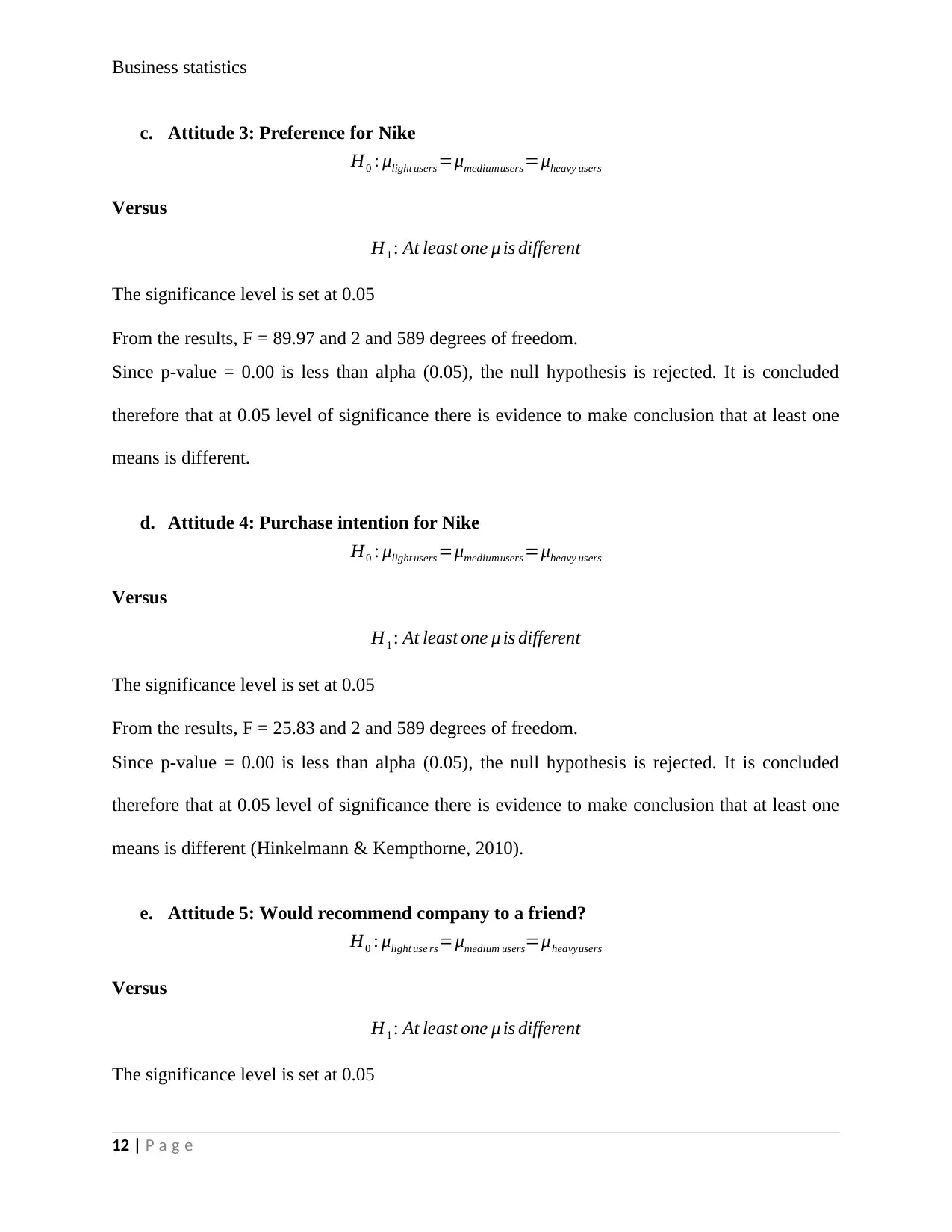
Business statistics
c. Attitude 3: Preference for Nike
H0 : μlight users =μmediumusers =μheavy users
Versus
H1 : At least one μ is different
The significance level is set at 0.05
From the results, F = 89.97 and 2 and 589 degrees of freedom.
Since p-value = 0.00 is less than alpha (0.05), the null hypothesis is rejected. It is concluded
therefore that at 0.05 level of significance there is evidence to make conclusion that at least one
means is different.
d. Attitude 4: Purchase intention for Nike
H0 : μlight users =μmediumusers =μheavy users
Versus
H1 : At least one μ is different
The significance level is set at 0.05
From the results, F = 25.83 and 2 and 589 degrees of freedom.
Since p-value = 0.00 is less than alpha (0.05), the null hypothesis is rejected. It is concluded
therefore that at 0.05 level of significance there is evidence to make conclusion that at least one
means is different (Hinkelmann & Kempthorne, 2010).
e. Attitude 5: Would recommend company to a friend?
H0 : μlight use rs=μmedium users=μheavyusers
Versus
H1 : At least one μ is different
The significance level is set at 0.05
12 | P a g e
c. Attitude 3: Preference for Nike
H0 : μlight users =μmediumusers =μheavy users
Versus
H1 : At least one μ is different
The significance level is set at 0.05
From the results, F = 89.97 and 2 and 589 degrees of freedom.
Since p-value = 0.00 is less than alpha (0.05), the null hypothesis is rejected. It is concluded
therefore that at 0.05 level of significance there is evidence to make conclusion that at least one
means is different.
d. Attitude 4: Purchase intention for Nike
H0 : μlight users =μmediumusers =μheavy users
Versus
H1 : At least one μ is different
The significance level is set at 0.05
From the results, F = 25.83 and 2 and 589 degrees of freedom.
Since p-value = 0.00 is less than alpha (0.05), the null hypothesis is rejected. It is concluded
therefore that at 0.05 level of significance there is evidence to make conclusion that at least one
means is different (Hinkelmann & Kempthorne, 2010).
e. Attitude 5: Would recommend company to a friend?
H0 : μlight use rs=μmedium users=μheavyusers
Versus
H1 : At least one μ is different
The significance level is set at 0.05
12 | P a g e
⊘ This is a preview!⊘
Do you want full access?
Subscribe today to unlock all pages.

Trusted by 1+ million students worldwide
1 out of 28
Related Documents
Your All-in-One AI-Powered Toolkit for Academic Success.
+13062052269
info@desklib.com
Available 24*7 on WhatsApp / Email
![[object Object]](/_next/static/media/star-bottom.7253800d.svg)
Unlock your academic potential
Copyright © 2020–2025 A2Z Services. All Rights Reserved. Developed and managed by ZUCOL.





